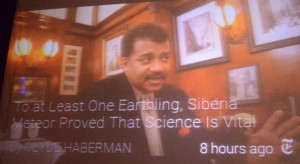
Last month I wrote a post for the Breaking Development Blog titled Beyond the Desktop. In that article, I discussed characteristics of this new design such as post-touch and snackable content. I summarized the pattern that I felt framed the future beyond simple RWD. It turns out I wasn’t the only one thinking about these things.
Basically, I outlined what has now been released as the Google Glass Mirror API. While Google has the first working implementation of this that I am aware of, I think it will soon be the way we design most interactions that take place…well…Beyond the Desktop.
After the blog post was released, I recorded a podcast with Josh Clark entitled Mundane Computing where we discussed the wide variety of devices that are either out now or nearly released that exhibit the behavior I described in the blog post. Josh actually added a very important characteristic that I had left out that may be the most crucial characteristic, migrating interfaces. A migrating interface is one that follows you from device to device maintaining state through the entire lifespan of the interaction.
Cameron Moll has been thinking about this too. At the Breaking Development Conference in Orlando, he gave a presentation titled Pitfalls & Triumphs of the Cross-Screen Experience (Luke Wroblewski’s Notes, Video of presentation) where he digs deep into the idea of the migrating interface. He went so far as to coin what he calls Molls Law – “The best interface is the one that’s within reach.”
As a technologist, I study tech trends and one that, despite a large distaste from certain tech segments, that embodies the aspects of a post-touch device is Google Glass. I think a good representation of an experience using Glass is from Tim O’Reilly in his initial thoughts on Glass.
Tim states that “It’s not what I expected! It’s a magical experience.” Despite not really being able to say why, but I attribute it to Molls Law. It is reducing the friction of some of the important things we want in a device, which is that it deals with consumption.
We consume much more information than we create every day. And Google Glass, via it’s post-touch characteristics, is highly optimized for providing us what we want when we want it.
Google has the right plan for the future of a device laden world. Mike Elgan, a tech journalist, has been releasing a number of articles (e.g. Google One Step Closer to ‘Creating a Mind’, Google’s Awesome Future: It’s In the Cards) that point to this coming future and Google has a strong lead.
We will always have desktops, tablets, and smartphones, but we need to move beyond thinking about interfaces as devices and start discussing ways of designing to interact with information no matter where it may be displayed, in a more persistent manner.